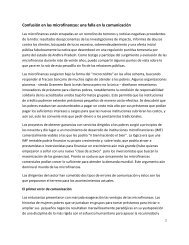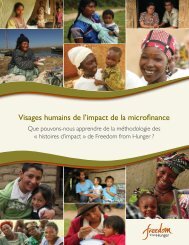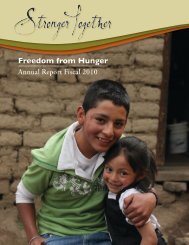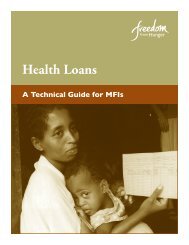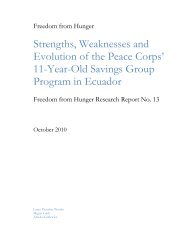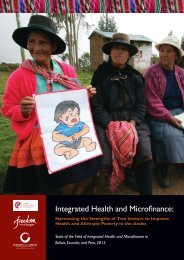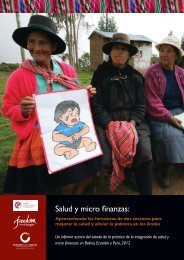history of meals for millions, soy, and freedom from ... - SoyInfo Center
history of meals for millions, soy, and freedom from ... - SoyInfo Center
history of meals for millions, soy, and freedom from ... - SoyInfo Center
You also want an ePaper? Increase the reach of your titles
YUMPU automatically turns print PDFs into web optimized ePapers that Google loves.
In 1958 General Mills relieved Gentry as the<br />
manufacturer <strong>of</strong> MPF. Eventually partially defatted <strong>soy</strong> grits<br />
were replaced by fully defatted <strong>soy</strong> grits, giving the product<br />
a higher protein content. And the following essential<br />
vitamins were added to the <strong>for</strong>mula: Vitamin C, vitamin E,<br />
vitamin B-6, <strong>and</strong> vitamin B-12.<br />
“Back in the days <strong>of</strong> the 3¢ postage stamp, the<br />
Foundation promoted MPF as ‘the 3¢ meal’; 2 ounces <strong>of</strong><br />
MPF, costing only 3¢, provided 1/3 <strong>of</strong> the MDR <strong>for</strong> many<br />
valuable nutrients likely to be lacking in the diet <strong>of</strong> low<br />
income families in developing countries.”<br />
Dr. Albert Schweitzer [who died in 1965] used MPF<br />
extensively at his hospital in Lambarene, Gabon. Dr. Tom<br />
Dooley [who died in Jan. 1961] used MPF in his MEDICO<br />
hospital in Laos. 80,000 lb <strong>of</strong> MPF were used in the Biafran<br />
war in Nigeria. During the prisoner exchange with Cuba’s<br />
Castro in the mid-1960s, over 800,000 lb <strong>of</strong> MPF were<br />
shipped to Cuba <strong>and</strong> converted into MPF sausage. After<br />
earthquakes in Morocco, Turkey, <strong>and</strong> Central <strong>and</strong> South<br />
America, MPF was donated in time to relieve severe cases<br />
<strong>of</strong> protein shortage. In 1960 it was flown to needy<br />
orphanages in Morocco.<br />
276. Meals <strong>for</strong> Millions Foundation. 1978. Annual report<br />
1977: A commitment to self-help <strong>for</strong> a hungry world. Santa<br />
Monica, Cali<strong>for</strong>nia: MFM Foundation. 9 panels. Each 9 x<br />
23 cm. Complex folding.<br />
• Summary: Peter J. Davies is President <strong>and</strong> Chief<br />
Executive Officer; he resides at the New York <strong>of</strong>fice. On the<br />
orange, black <strong>and</strong> white cover is a photo <strong>of</strong> a little girl.<br />
MFM’s <strong>for</strong>mer logo <strong>of</strong> the plant growing in the upturned<br />
bowl is now at the bottom <strong>of</strong> the cover.<br />
Contents: Message <strong>from</strong> the president (The “trickledown”<br />
theory <strong>of</strong> investing in infrastructure does not work).<br />
Highlights <strong>of</strong> 1977: The Borsook Fund was established, the<br />
National Committee <strong>of</strong> Sponsors was <strong>for</strong>med, with Mrs.<br />
John Steinbeck as chairperson, generous grants were<br />
received <strong>from</strong> a long list <strong>of</strong> organizations, starting with US<br />
AID <strong>and</strong> PACT. Since 1974 MFM has emphasized self-help<br />
programs. moving away <strong>from</strong> distribution <strong>of</strong> MPF.<br />
Technical <strong>and</strong> material assistance (Ecuador, Honduras,<br />
Egypt, Korea, Jamaica, Kenya). Transfer <strong>of</strong> technology<br />
(Village texturizer, India–Robert <strong>and</strong> Jeanne Nave). Multi-<br />
Purpose Food (sent to Syracuse, New York). Technical <strong>and</strong><br />
pr<strong>of</strong>essional training (IIPFT, Bolivia). Nutrition education<br />
(Tucson, Arizona. In June 1977 MFM held its first Nutrition<br />
Education Workshop <strong>for</strong> 28 field nutritionists).<br />
Income <strong>for</strong> 1977 by source: $893,765 (total). Statement<br />
<strong>of</strong> functional expenses <strong>for</strong> the year ended Dec. 31, 1976<br />
($529,028). Board <strong>of</strong> Trustees. National Committee <strong>of</strong><br />
Sponsors. MFM <strong>of</strong>ficers. A small portrait photo shows Peter<br />
Davies. Address: 1. 1800 Olympic Boulevard (P.O. Box<br />
680), Santa Monica, Cali<strong>for</strong>nia 90406; 2. 815 Second Ave.,<br />
MEALS FOR MILLIONS, SOY, AND FREEDOM FROM HUNGER 119<br />
© Copyright Soyinfo <strong>Center</strong> 2011<br />
Suite 501, New York City, NY 10017. Phone: (213) 829-<br />
5337 or (212) 986-4170.<br />
277. Chen, Philip S.; Chung, Helen D. 1978. Soybeans <strong>for</strong><br />
health <strong>and</strong> longer life. New Canaan, Connecticut: Keats<br />
Publishing, Inc. xii + 178 p. Index. 18 cm. (A Pivot Health<br />
Book).<br />
• Summary: A revised <strong>and</strong> condensed pocketbook version<br />
<strong>of</strong> Chen <strong>and</strong> Chen 1956. Contents: Preface. Foreword.<br />
Introduction. Part I: Nutritive value <strong>of</strong> the <strong>soy</strong>bean. 1.<br />
Protein. 2. Fat. 3. Carbohydrates <strong>and</strong> caloric value. 4.<br />
Minerals. 5. Vitamins. 6. Soybeans <strong>and</strong> world population. 7.<br />
Soybeans <strong>and</strong> disease.<br />
Part II: Soy products. 8. Soybean oil: Phosphatides,<br />
margarine. 9. Soybean oil meal: Gel<strong>soy</strong>, Multi-Purpose<br />
Food. 10. Soy flour. 11. Concentrated <strong>soy</strong> protein products:<br />
Soy protein concentrates (Griffith Laboratories makes<br />
Isopro <strong>and</strong> GL-301), <strong>soy</strong> protein isolates, <strong>and</strong> textured or<br />
spun <strong>soy</strong> proteins. 12. Soy milk. 13. Soy cheese (t<strong>of</strong>u). 14.<br />
Soy sauce. 15. Soybean sprouts.<br />
Part III: Soybean culture <strong>and</strong> preservation. 16. Soybean<br />
culture. 17. Preservation <strong>of</strong> <strong>soy</strong>beans (preserving green<br />
<strong>soy</strong>beans by canning, freezing, <strong>and</strong> dehydration).<br />
Part IV: Recipes. 18. Soybeans <strong>and</strong> <strong>soy</strong>bean pulp. 19.<br />
Soy flour: Breads, cakes, cookies, pies, soups, other recipes.<br />
20. Soy grits <strong>and</strong> <strong>soy</strong> flakes. 21. Soy milk. 22. Soy cheese.<br />
23. Soybean sprouts. Appendix: Soybean utilization (chart).<br />
References. Address: 1. PhD; 2. M.S. Both: USA.<br />
278. Smith, Allan K.; Circle, S.J. eds. 1978. Soybeans:<br />
Chemistry <strong>and</strong> technology. Vol. 1. Proteins. Revised.<br />
Westport, Connecticut: AVI Publishing Co. xiii + 470 p.<br />
Illust. Index. 24 cm. [500+ ref]<br />
• Summary: This revised edition contains relatively few,<br />
unimportant changes <strong>from</strong> the original, classic 1972 edition.<br />
The following changes have been made: Addition <strong>of</strong> a 7line<br />
preface to the “revised second printing” dated 4 Oct.<br />
1977, updating <strong>of</strong> a graph <strong>of</strong> U.S. <strong>soy</strong>bean production (p.<br />
1). Updating (to 1976) <strong>of</strong> a table on U.S. <strong>and</strong> world<br />
production <strong>of</strong> important oilseeds (<strong>soy</strong>beans, cottonseeds,<br />
peanuts, sunflower, rape, sesame) (p. 2). Minor textual<br />
changes on pages 18-19. Addition <strong>of</strong> a table showing<br />
distribution <strong>of</strong> the 3 leading <strong>soy</strong>bean varieties in 14 major<br />
states <strong>and</strong> the percentage <strong>of</strong> acreage harvested <strong>for</strong> each<br />
variety in 1976 (e.g., in Illinois, Williams accounted <strong>for</strong><br />
25.1% <strong>of</strong> harvested acreage, Am<strong>soy</strong> 17.3%, <strong>and</strong> Wayne<br />
12.8%). And updating <strong>of</strong> a table on U.S. <strong>soy</strong>bean production<br />
by state showing acreage harvested, yield per acre, <strong>and</strong><br />
production <strong>for</strong> 1974, 1975, <strong>and</strong> 1976 (p. 32).<br />
The <strong>for</strong>eword, chapter titles, <strong>and</strong> index have not been<br />
changed at all. Note: Vol. 2 was never published. Address:<br />
1. Oilseeds protein consultant, Hot Springs, Arkansas; 2.<br />
Oilseed protein consultant, Protein Technology, Richardson,<br />
Texas.



